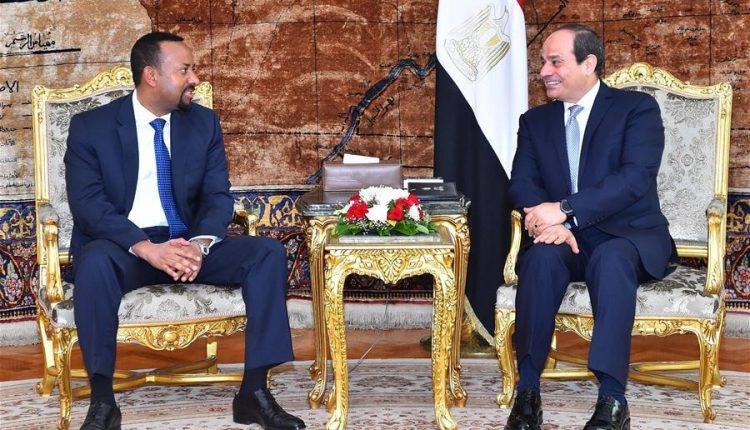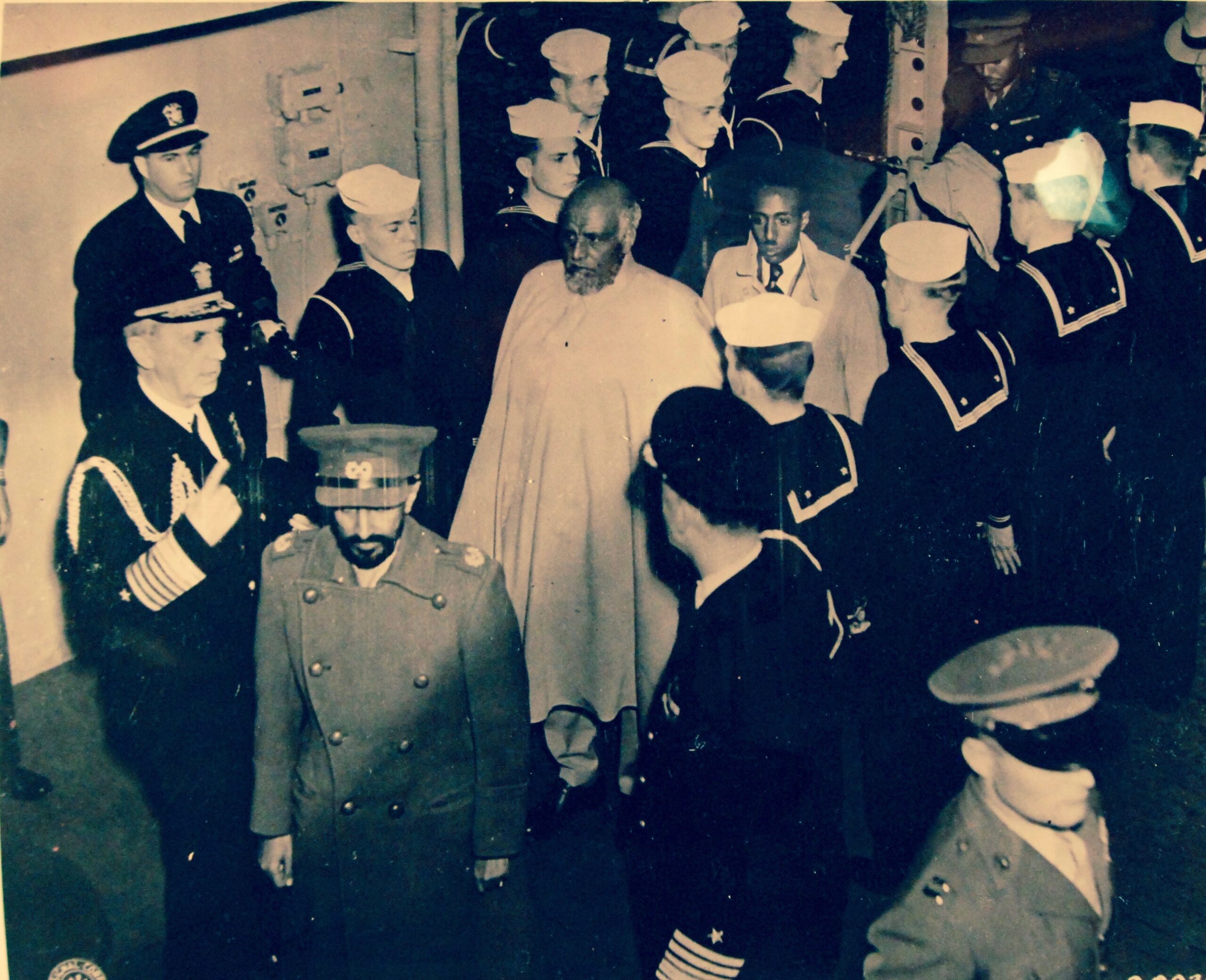Tensions between Ethiopia and Egypt go back decades and reveal a web of Cold War intrigue, clandestine diplomacy and internal meddling. With Cairo winning friends and Addis Ababa making enemies, can a regional conflagration be averted?

Days of amity: Ethiopia’s PM Abiy Ahmed and Egypt’s President Abdel Fatah el-Sisi in Sept 2018. Photo courtesy: The Ministry of Foreign Affairs of Ethiopia.
At the beginning of 2024, Ethiopian Prime Minister Abiy Ahmed, who has been at war with his own people for the past five years, stirred regional tensions by signing a Memorandum of Understanding (MoU) with Somaliland. At home, he sought to win public support by selling the deal as Ethiopia’s long-sought access to the sea. The Ethiopian government announced that the agreement involved establishing a naval base and maritime services in the Gulf of Aden. This move, however, was met with strong opposition from Somalia, which condemned the MoU as illegal and a violation of Somalia’s territorial integrity, given Somaliland’s contested status as a breakaway region.
Somalia strengthened its naval defence by establishing treaties with Turkey and Egypt. Egypt, in particular, increased its military support to Somalia, reportedly sending arms shipments and deploying troops to the region. These developments have added a new layer of complexity to regional dynamics, with concerns about escalating tensions between the countries involved. Ethiopia’s Foreign Ministry issued a strong statement saying that it cannot stand idle while other actors are taking measures to destabilise the region. Ethiopia, it added, is monitoring developments in the region that could threaten its national security.
The Director General of Ethiopia’s Intelligence and Security Agency, Redwan Hussein, reiterated Ethiopia’s ambitions on September 8: “It is not about finding alternative ports, as we can use Port Sudan, Lamu [and/or] Berbera. What we need is an access [point] to the sea [that] we can invest and defend. We have lost this opportunity four times: during Menelik’s time, where after winning the war at Adwa, he should have proceeded to the sea. We [also] lost it during [the] Haile Sellasie, Mengistu and EPRDF [eras]. Now is the right time to fulfil it, have access to the sea.”
Egyptian forces are now near Somalia’s border with Ethiopia and could soon be stationed near the Grand Ethiopian Renaissance Dam (GERD), given Sudan’s instability. Egypt and Eritrea are also exploring military co-operation and intelligence-sharing. Egypt is also brokering a possible reconciliation between the Eritrean regime and the Tigray Peoples’ Liberation Front (TPLF) – sworn enemies until the 2022 US-mediated peace deal in Pretoria put Eritrea’s Isaias Afwerki at odds with Abiy Ahmed.
Egypt has signed several agreements with Djibouti in 2022 and with other Ethiopian neighbours such as Kenya and Uganda. It has even recently signed a defence agreement with Nigeria. Effectively, this suggests the encircling of Ethiopia from all sides. Ethiopia’s only friend in the region is the UAE (which is in good standing with Egypt) but the relations are based more on personal relations between Abiy and President Mohamed Bin Zayed al-Nahyan than solid state-to-state relations.
Egyptian troops on foreign soil

Egyptian Army in Sanaa, Yemen, 1962. Photo by العمري – http://alamree.net/alboum-sanaa_8.htm, Public Domain https://commons.wikimedia.org/w/index.php?curid=38047588
The stationing of Egyptian troops in Somalia, if it comes to fruition, would mark Cairo’s first deployment since 1962 when Nasser sent 70,000 troops to Yemen. By their departure in 1970, 10,000 of them had been killed, with external forces supporting the Yemeni rebels. The conflict was dubbed Egypt’s Vietnam and may have contributed to its defeat by Israel in the Six Day War of June 1967.
The current deployment reflects long-standing tensions between Ethiopia and Egypt, rooted in unresolved issues from the mid-20th century. Ethiopia has the right to generate electricity from GERD, while Egypt equally needs to secure its water supply. A win-win solution is vital for over 200 million people and regional stability.
On the other hand, both Ethiopia and Somalia face critical internal challenges that must be prioritised and addressed. On 5 September 2018, Ethiopia, Eritrea, and Somalia, under President Farmajo, signed a tripartite agreement focusing on mutual respect for each other’s independence, sovereignty, and territorial integrity. However, this agreement, along with a prior agreement between Ethiopia and Eritrea, was more of an arrangement between the leaders rather than a formal institutional agreement. Not surprisingly, the pact would soon unravel.
In 2020, Somalia’s current president Hassan Sheikh Mohamud criticised the tripartite agreement, pointing out that neither Ethiopia nor Somalia were ready for deeper integration at the time. He argued that Ethiopia was increasingly unstable due to internal ethnic conflicts and border disputes with both Somalia and Eritrea. Somalia, meanwhile, was too politically fragmented and vulnerable to extremist threats to benefit from regional integration. He also emphasised that Somalia’s leaders had adopted Ethiopia’s integration agenda without adequately consulting civil society or the public, which risked deepening internal divisions instead of fostering unity.
This perspective highlighted the challenges facing regional integration in the Horn, with each country’s internal vulnerabilities acting as significant barriers to meaningful cooperation. Somalia needs to resolve its ongoing clan conflicts before engaging effectively with external actors.
Tensions over the Nile date back decades. Britain’s mediation, linking water projects to energy development, did little to ease Ethiopian concerns.
The growing tensions between Egypt and Ethiopia in the 1950s were fuelled by three key issues following Nasser’s rise to power in 1952. First, the Ethiopian Orthodox Church’s administration, long controlled by Egypt’s Coptic Church, became a point of contention. Ethiopia sought greater religious independence, culminating in 1959 when it gained full autonomy, reducing Egypt’s influence.
Second, Ethiopia clandestinely but officially committed to decolonisation in Africa, opposed the withdrawal of British forces from Egypt in 1954. Recently declassified British documents obtained by the BBC, revealed that Haile Selassie urgently appealed to British officials, asking them not to withdraw their troops from Egypt. He argued that Egypt would use the power vacuum to exert control over Sudan, posing a threat to Ethiopia. He feared Egyptian troops would monitor Ethiopia from the Sudanese border, heightening regional tensions. Further complicating matters was Ethiopia’s response to the rise of the National Unionist Party in Sudan, which had strong ties to Egypt. British documents also reveal Haile Selassie’s efforts to encourage Sudanese unity and independence after the British departure, with the hope of countering Egyptian influence.
Hidden players in the Suez Crisis

Emperor Haile Selassie of Ethiopia aboard USS Quincy (CA 71) on Great Bitter Lake on the Suez Canal near Cairo. The President was returning from the Crimea Conference, February 13, 1945. He is escorted by Fleet Admiral William D. Leahy, USN. U.S. Army Signal Corps. Source: Office of War Information Collection. (30/08/2016).
Third, Egypt’s construction of the Aswan Dam and the nationalisation of the Suez Canal in 1956 further strained relations. These events symbolised Egypt’s growing influence, which Ethiopia viewed with increasing suspicion, particularly concerning the control over the Nile. This concern over Egypt’s expanding influence extended beyond Sudan’s borders, especially as events surrounding the Suez Canal unfolded.
In September 1955, Egypt secured an arms deal with Czechoslovakia, leading the U.S. to offer financial aid for the Aswan Dam to counter the Czechs. Ethiopia, alarmed by Nasser’s revival of plans to control the Nile Valley, was not consulted. By July 1956, the U.S. had withdrawn its support for the dam due to Egypt’s geopolitics, notably its recognition of communist China. In response, Nasser nationalised the Suez Canal in 1956, previously operated by Britain and France.
Britain and France proposed an international administration for the canal, ‘The Suez Canal Users’ Association (SCUA) which would exclude France, Britain and Egypt, denying Egypt outright sovereignty over the canal. On August 18, 1956, U.S. Secretary of State, John Foster Dulles proposed that neutral nations, including Ethiopia, be included and be sent to inform Nasser of the decision. However, Nasser opposed Ethiopia’s inclusion, retaliating by banning Ethiopian Airlines access to Egyptian airspace and promoting Eritrean, Ogaden, and Somaliland independence through Egyptian radio.
During the Suez Crisis of October-November 1956, Ethiopia, under Emperor Haile Selassie, publicly maintained a neutral stance, advocating for diplomacy. The crisis ended with UN intervention, and by early 1957, British, French, and Israeli forces withdrew. Nasser emerged the political victor, boosting his popularity in the Arab world and signalling the decline of British and French imperial power, with U.S. and the Soviet influence in the Middle East ascendant.
On 16 April 1957, Kamal Al Din Salah, an Egyptian diplomat and the chairperson of the United Nations Advisory Council for Somalia (Italian Somaliland), was murdered in Mogadishu. Salah had been using his position to advocate for Somalia’s independence, leveraging UN resources to promote this cause. His assassination sparked a long and contentious police investigation, which fuelled tensions within the Somali nationalist movement.

Al Ahram newspaper during the Suez Crisis, 1956.
On 20 April, a news article in the Cairo newspaper Akhbar al-Youm, accused Ethiopia of plotting the murder of Salah. Ordinary Somalis took to the streets in protest, with some expressing outrage over the murder, while others criticised Egypt’s influence over the nationalist cause.
The incident highlighted the complexities of Somalia’s path to independence and the external pressures shaping its political future. Such events may happen again, escalating tensions.
During the 1960s to 1990s, Egypt-Ethiopia relations were shaped by Cold War geopolitics. Under Nasser, Egypt supported African liberation movements and was a founding member of the Organisation of African Unity, gave sanctuary to the families of Lumumba and Nkrumah, and offered free scholarships to African students. Haile Selassie, on the other hand, positioned Addis Ababa as the continent’s historical and administrative centre via the OAU while his closeness to the West was his diplomatic bulwark against Nasser’s Egypt.
After Nasser’s sudden death in 1970 – of a heart attack; he was 52 – tensions escalated. Under his successor, Anwar Sadat and Ethiopia’s Mengistu Haile Mariam, the two states swapped ideological allegiances. Egypt, aligning with the West after Sadat expelled Soviet advisors in 1972, became a U.S. ally; Mengistu’s Marxist-Leninist regime aligned Ethiopia with the Soviet Union in 1977, incidentally, in the middle of the Ogaden War against Somalia, a socialist state under Siad Barre, which then promptly swapped Moscow for Washington. This ideological divide deepened the rift between the states, limiting cooperation.
The Mad Man Who Threw Bottles of Blood

Leading members of the Derg; Mengistu Haile Mariam, Teferi Bante and Atnafu Abate. Source unknown; courtesy: Wikimedia commons
A major source of Ethiopian-Egyptian tension was Cairo’s perceived covert support for Eritrean independence movements during Mengistu’s rule, compounded by the ongoing Nile water dispute. In 1980, Ethiopia filed a complaint against Egypt at the Organisation of African Unity after Sadat proposed diverting Nile waters to the Sinai Peninsula. Sadat mockingly referred to Mengistu as “the mad guy throwing bottles of blood” after the Ethiopian leader’s dramatic anti-imperialist speech throwing bottles filled with red liquid.
Throughout the 1980s, Ethiopia’s internal struggles, including the Eritrean independence movement, famine, and civil war, prevented it from challenging Egypt on water rights, while Egypt focused more on Middle Eastern diplomacy.
By the 1990s, the collapse of the Soviet Union ended Mengistu’s rule, but Egypt’s Nile policies continued under Hosni Mubarak. Egypt shifted focus away from Africa, especially after a 1995 assassination attempt on Mubarak in Addis Ababa. Under President Abdel Fattah el-Sisi, Egypt has re-engaged with Africa, strengthening ties through investments and defence pacts with Ethiopia’s neighbours. Egypt now makes peacekeeping contributions in regions like South Sudan and the DRC. Egypt’s involvement in Libya, Sudan, and deploying troops to Somalia reflects strategic concerns that echo Haile Selassie’s 1950s fears of Egyptian military presence near Ethiopia.
Dispute Over Agreements On The Nile

Smoke rises from oil tanks beside the Suez Canal hit during the initial Anglo-French assault on Port Said, 5 November 1956. Courtesy: https://commons.wikimedia.org/wiki/File:Port_Said_from_air.jpgv
At the core of strained relations is the ongoing Nile water dispute. The 1929 Anglo-Egyptian Treaty was signed by Britain on behalf of its colonies. Its objective was to expand the areas under cotton cultivation that supplied Britain’s garment industry. The 1959 Egypt-Sudan agreement consolidated the previous agreement allocating most of the Nile’s water to Egypt and Sudan, and neglecting upstream countries like Ethiopia, which contributes over 80% of the Nile’s flow. Egypt sees these agreements as binding and has threatened military action to protect its water rights.
In March 2015, Egypt, Ethiopia, and Sudan signed a Declaration of Principles (DoP) to address disputes over Ethiopia’s Grand Ethiopian Renaissance Dam (GERD). However, the agreement lacked clarity and enforceable mechanisms, failing to resolve key disagreements. In July 2020, Ethiopia began filling the dam’s reservoir, escalating tensions. Egypt and Sudan viewed this as a breach of the DoP, while Ethiopia defended its sovereign right to proceed.
Sub-Saharan Africa generally supports Ethiopia, while the Arab League, under Egypt’s influence, backs Egypt, leading to tensions between African and Arab nations. This dynamic was highlighted by Egyptian backlash against a Netflix series portraying Cleopatra as Black, reflecting bias.
In a parliamentary speech, Meles Zenawi detailed Egypt’s strategies against Ethiopia, which included obstructing funding for the dam, leveraging external proxies like Eritrea, and stirring internal unrest by supporting opposition groups to distract Ethiopia from its progress. While he estimated the likelihood of a direct Egyptian military attack at just five percent, Meles stressed the importance of being prepared. Notably during the EPRDF era, both the Oromo Liberation Army (OLA) and Ginbot 7 (a coalition of Amhara organizations, chaired by Ethiopia’s current Education Minister) were based in Eritrea and, allegedly, backed by Egypt.
However, what stands out even more is that Abiy Ahmed, during his tenure with Ethiopia’s National Intelligence and Security Service (INSA), publicly admitted after becoming Prime Minister that he had previously shared sensitive security information with both groups. OLA admitted those revelations. Shortly after taking office, Abiy even characterised the GERD project as politically motivated, but later shifted his stance when he realised it had overwhelming public support.
Unresolved tensions

Cuban artillery crew during the Ogaden War. Source: Cuban Armed Forces courtesy, Wikimedia Commons
Egyptian troops are now deployed in Somalia, and tensions over the GERD continue to simmer. Ethiopia’s ambition to harness the Nile’s resources has reignited old rivalries. Egypt remains determined to protect its historic rights to the Nile, while Ethiopia insists on its sovereign right to develop the river for electricity generation. As these two nations grapple with their legacies and futures, only renewed dialogue and mutual compromise can pave the way for lasting peace and stability in the region.
Despite Ethiopia completing the filling of the GERD, Egypt and Sudan remain concerned about potential water shortages, especially during dry periods when the Nile’s flow may decrease. This ongoing deadlock reflects the unresolved tensions Haile Selassie foresaw in the 1950s — Egypt’s military and political influence continues to be a significant factor in the region, while Ethiopia faces both internal and external challenges.
As Meles Zenawi predicted, it is less likely that Egypt will attack Ethiopia directly as it has strategic advantages over Ethiopia, not only in military power, but also diplomatically; there many proxies that it can employ both inside and outside Ethiopia. Ethiopia, similarly, has proxies inside the loose federal arrangement in Somalia. The stakes extend beyond Ethiopia and Egypt, affecting the entire region that relies on the Nile for its survival.





